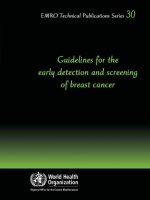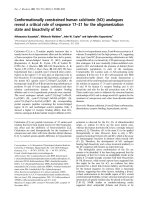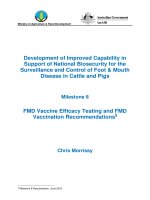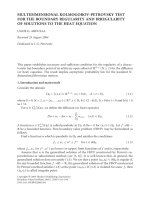HYDRODYNAMIC DELIVERY FOR THE STUDY, TREATMENT AND PREVENTION OF ACUTE KIDNEY INJURY
Bạn đang xem bản rút gọn của tài liệu. Xem và tải ngay bản đầy đủ của tài liệu tại đây (14.09 MB, 268 trang )
HYDRODYNAMIC DELIVERY FOR THE STUDY, TREATMENT AND
PREVENTION OF ACUTE KIDNEY INJURY
Peter R. Corridon
Submitted to the faculty of the University Graduate School
in partial fulfillment of the requirements
for the degree
Doctor of Philosophy
in the Program of Biomolecular Imaging and Biophysics
Indiana University
October 2013
!
!
!
!
!
!
ii!
Accepted by the Graduate Faculty, of Indiana University, in partial
fulfillment of the requirements for the degree of Doctor of Philosophy.
Simon J. Atkinson, Ph.D., Chair
Robert L. Bacallao, M.D.
David P. Basile, Ph.D.
Doctoral Committee
Kenneth W. Dunn, Ph.D.
August 12, 2013
Vincent H. Gattone II, Ph.D.
!
!
!
!
!
!
iii!
© 2013
Peter R. Corridon
!
!
!
!
!
!
iv!
DEDICATION
I dedicate this dissertation to Dr. Vincent H. Gattone II - a valued member of my
dissertation committee. The time we spent working side by side on optimizing the
hydrodynamic injection process led me to this critical point. Your mentorship, kind
consideration and friendship will always be appreciated and remembered.
!
!
!
!
!
!
v!
ACKNOWLEDGMENTS
I would like to thank my mentor Dr. Simon Atkinson for his earnest commitment
to my academic and personal development. Since my first meeting with Dr. Atkinson
prior to my move to Indianapolis, and until this day, he has been a monumental part of
my life. His guidance and support will forever be appreciated and never forgotten.
I would like to the other members of my doctoral committee, Drs. Robert L.
Bacallao, David P. Basile, Kenneth W. Dunn and Vincent H. Gattone II. Individually the
each imprinted on me their unique approaches biological scientific investigations and
afforded me invaluable amounts of time, advice and support throughout my at IUPUI on
scientific matters and those that extended beyond the laboratory.
I would also like to thank the existing and past members of the Atkinson lab with
whom I have interacted on a near daily basis for the past four years: Dr. Mark A. Hallett,
Ms. Shijun Zhang and Dr. Hao Zhang. These individuals gave selflessly to my academic
development as they directly aided my experimental work and provide crucial scientific
critiques.
I would like to especially thank Dr. George J. Rhodes: you transformed an
engineer into a surgeon with your tireless efforts to improve my technique and
understanding of each surgical model we investigated, while being a valued friend and
confident.
I would like to thank all the members of the Bacallao, Dagher, Molitoris and
Sutton labs for the time each member took to assist my training and development in
!
!
!
!
!
!
vi!
biochemistry, animal surgeries and intravital microscopy.
I would like to thank Drs. Sherry Queener, Associate Dean of the IU Graduate
School and Director, IUPUI Graduate Office; Dr. Kenneth B. Durgans, past Vice
Chancellor for Diversity, IUPUI; Dr. Simon J. Rhodes, Dean, School of Science IUPUI;
Ms. Monica Henry, Director of Graduate business Programs in Medicine, Kelly School
of Business, IUPUI; Dr. Richard N. Day, Professor of Cellular & Integrative Physiology
and Director of Biomolecular Imaging and Biophysics Program, IU School of Medicine;
Dr. Joseph P. Bidwell, Professor of Anatomy & Cell Biology; Dr. Randy R. Brutkiewicz,
Professor of Microbiology & Immunology and Associate Dean for Graduate Studies, Dr.
Jonathan D. Tune, Associate Professor of Cellular & Integrative Physiology, and Adam
Goodwin, Postdoctoral Fellow of Cellular & Integrative Physiology, for their interests
and support in my advancement in research - your patience, advice and support will be
cherished for the rest of my life.
Finally, I would like to thank all the members of my family and friends, in
particular my deceased father; mother; wife; and daughter – your love, support and
appreciation are without a doubt the major elements that have lead me to this point and
will help me to succeed in the future.
!
!
!
!
!
!
vii!
ABSTRACT
Peter R. Corridon
HYDRODYNAMIC FLUID DELIVERY FOR THE STUDY, TREATMENT AND
PREVENTION OF ACUTE KIDNEY INJURY
Advancements in human genomics have simultaneously enhanced our basic
understanding of the human body and ability to combat debilitating diseases. Historically,
research has shown that there have been many hindrances to realizing this medicinal
revolution. One hindrance, with particular regard to the kidney, has been our inability to
effectively and routinely delivery genes to various loci, without inducing significant
injury. However, we have recently developed a method using hydrodynamic fluid
delivery that has shown substantial promise in addressing aforesaid issues. We optimized
our approach and designed a method that utilizes retrograde renal vein injections to
facilitate widespread and persistent plasmid and adenoviral based transgene expression in
rat kidneys. Exogenous gene expression extended throughout the cortex and medulla,
lasting over 1 month within comparable expression profiles, in various renal cell types
without considerably impacting normal organ function. As a proof of its utility we by
attempted to prevent ischemic acute kidney injury (AKI), which is a leading cause of
morbidity and mortality across among global populations, by altering the mitochondrial
proteome. Specifically, our hydrodynamic delivery process facilitated an upregulated
expression of mitochondrial enzymes that have been suggested to provide mediation from
!
!
!
!
!
!
viii!
renal ischemic injury. Remarkably, this protein upregulation significantly enhanced
mitochondrial membrane potential activity, comparable to that observed from ischemic
preconditioning, and provided protection against moderate ischemia-reperfusion injury,
based on serum creatinine and histology analyses. Strikingly, we also determined that
hydrodynamic delivery of isotonic fluid alone, given as long as 24 hours after AKI is
induced, is similarly capable of blunting the extent of injury. Altogether, these results
indicate the development of novel and exciting platform for the future study and
management of renal injury.
Simon J. Atkinson, Ph.D., Chair
!
!
!
!
!
!
ix!
TABLE OF CONTENTS
List of Tables xvi
List of Figures xvii
I. Introduction 1
A. Acute kidney injury 1
1. The growing prevelance of renal injury 1
2. AKI: A significant clinical problem 2
3. Classification and pathogenesis of AKI 3
4. Present management of AKI 5
B. Genetic medicine: a novel alternative for the study and
management of AKI 7
1. The promise of genetic medicine 7
2. Efforts to devise effective AKI gene monitoring and
treatment strategies 9
a. Recombinant peptides and proteins 9
b. Cell transplantation 11
c. RNAi therapy 12
3. Mechanisms for exogenous transgene expression in
mammalian cells 15
4. Key aspects to facilitate advancements in renal genetic
medicine 17
a. The development of efficient renal gene delivery
techniques 17
b. Exogenous transgene vectors 21
C. Multiphoton microscopy: a novel tool for renal genetic medicine 24
1. Biomedical applications of optical microscopy 24
2. Applications of multiphoton microscopy for monitoring
renal gene expression 26
3. Fundamentals of intravital multiphoton fluorescence
microscopy 27
a. Fluorescence excitation and emission 27
b. Lasers: practical ways to generate multiphoton
excitation fluoresence 30
c. Image formation in multiphoton fluoresence
microscopy 32
d. In vivo, ex vivo and in vitro multiphoton imaging
of mammalian tissues 34
D. Hypothesis 37
II. Materials and Methods 41
A. Cell culture and live animals 41
1. Cell culture 41
a. Mouse kidney cell culture 41
b. MDCK cell culture 41
!
!
!
!
!
!
!
x!
2. Live rats 41
3. Live pigs 42
B. Mild, acute and severe models of renal injury 42
1. Gentamicin toxicity 42
2. Ischemia-reperfusion injury 42
a. Bilateral clamp model 42
b. Contralateral nephrectomy and unilateral clamp
model 43
c. Ischemic preconditioning 43
C. Serum creatinine measurements 43
D. Cell and tissue markers 44
1. Tolonium chloride 44
2. Fluorescent cell and tissue markers 44
3. X-ray/CT contrast agents 45
4. Plasmid vectors 45
5. Baculovirus vectors 46
6. Adenovirus vectors 46
E. Cell culture transfection and transduction protocols 46
1. Expression of a single transgene vector 46
2. Simultaneous expression of multiple transgene vectors 47
F. Exogenous fluid delivery to the kidneys of live animals 47
1. Jugular vein infusions in live rats 47
2. Tail vein injections in live rats 47
3. Renal capsule injections in live rats 48
4. Hydrodynamic infusions in live rats 48
a. Renal artery catheter-based injections 48
b. Renal artery fine-needle injections
(without vascular cross-clamps) 48
c. Renal artery fine-needle injections
(with vascular cross-clamps) 50
d. Retrograde renal vein catheter-based injections 50
e. Retrograde renal vein fine-needle injections
(without vascular cross-clamps) 50
f. Retrograde renal vein fine-needle injections
(with vascular cross-clamps) 51
5. Monitoring vital signs during renal vein hydrodynamic
retrograde infusions in live rats 51
6. Critical parameters for retrograde renal vein hydrodynamic
injections in live rats 53
7. Hydrodynamic delivery facilitates the endocytic uptake of
virions in live rat kidneys 53
8. Hydrodynamic retrograde venous delivery in rats with
ischemia-reperfusion injury 54
9. Hydrodynamic retrograde portal vein injections in live rats 54
!
!
!
!
!
!
!
xi!
10. Renal artery and vein infusions in live Ossabaw swine 54
a. Low rate arterial and retrograde venous infusions
into the renal vein of Ossabaw swine 54
b. Hydrodynamic retrograde injection into the renal
vein of Ossabaw swine 55
11. Monitoring vital signs during renal vein hydrodynamic
retrograde infusions in live pigs 56
G. Cell and tissue imaging 57
1. Fluorescence microscopy 57
a. Confocal fluorescence imaging of live cells 57
b. Spectral analyses to identify transgene fluorescence 57
c. Intravital two-photon fluorescence microscopy 57
d. Two-photon imaging of freshly excised tissues 59
e. Texas- red phalloidin and GFP-actin colocalization
to verify transgene expression 59
f. Estimations of transgene delivery efficiencies 59
i. In vivo renal transgene delivery efficiencies 59
ii. In vitro renal transgene delivery efficiencies 60
g. Functional and structural analyses using fluorescent
albumin and dextrans following transgene delivery
and fluorescent protein expression 60
h. Investigating the correlation between hydrodynamic
injection parameters and reliable transgene expression 62
i. Investigating whether hydrodynamic forces facilitate
the endocytic uptake of virions in vivo 62
j. Estimations of mitochondrial activity in live rat
kidneys based on TMRM fluorescence intensities 63
2. Histology and renal injury assessment 63
3. Fluoroscopy/cinematography to monitor uptake of
exogenous dyes in live pig kidneys 65
H. Western blot analysis 65
I. Statistical analysis 67
III. Results 68
Chapter 1. The design and characterization of various methods to
facilitate and monitor transgene expression in the rat kidney 68
A. Fluorescent protein expression in cultured cells using plasmid,
baculovirus and adenovirus vectors 68
B. Rat kidney tissue autoflouresence, structure and function
examined with intravital two-photon fluorescence microscope 72
1. Rat kidneys investigated under normal physiological
conditions 72
a. Tissue autofluoresence in normal rats visualized
Using two-photon excitations wavelengths that
range from 800 to 860 nm 72
!
!
!
!
!
!
!
xii!
b. Renal structure and function in normal rats 74
2. Rat kidneys investigated under nephrotoxic and ischemic
conditions 74
a. Tissue autoflouresence, structure and function in
the setting of gentamicin-induced nephrotoxicity 74
b. Tissue autoflouresence, structure and function in
the setting of ischemia-reperfusion injury 78
C. Characterizations of various methods designed to deliver
exogenous fluid to the kidney 81
1. Systemic fluid delivery to the kidney in normal rats via
jugular and tail vein infusions 81
2. Localized fluid delivery of fluid to the kidneys of normal
rats 81
a. Renal capsule infusions in live normal rat kidneys 81
b. Hydrodynamic fluid delivery in live normal rat
kidneys 85
i. Catheter-based renal artery infusions 85
ii. Catheter-based renal vein infusions 85
iii. Fine-needle hydrodynamic renal artery
injections of fluorescent dextrans with
vascular clamps 88
iv. Fine-needle renal vein injections of
fluorescent dextrans without and with
vascular clamps 88
v. Fine-needle renal vein injections of toluidine
blue dye without and with vascular clamps 96
D. Plasmid- and viral-mediated transgene expression in live rats 99
1. Tissue autofluoresence is unalterted by the fluid
delivery process 99
2. Systemic transgene delivery did not facilitate
renal transgene expression 99
3. Low levels of plasmid expression and significant levels
of renalinjury generated from fine-needle renal artery
hydrodynamic injections 101
4. Minimal plasmid expression generated from low
volume (0.2 ml), fine-needle renal vein hydrodynamic
injections conducted without vascular clamps 106
5. Large volume (0.5-1 ml) fine-needle renal vein retrograde
hydrodynamic injections, conducted without vascular
clamps, into the renal vein improved levels of viral transgene
expression in live rats 106
6. Texas red-labeled phalloidin and fluorescent actin
colocalization observed in vitro verify results obtained from
live rats 112
!
!
!
!
!
!
!
xiii!
7. Vascular cross-clamping significantly improved plasmid and
adenoviral expression in various renal cell types with large
volume (0.5 ml) fine-needle retrograde hydrodynamic renal
vein delivery 113
8. Simultaneous expression of multiple transgene vectors
generated by single hydrodynamic injections augmented
with vascular cross-clamps 128
9. Hydrodynamic renal vein injections augmented with
vascular cross-clamping can generate efficient levels of
transgene expression in mammalian kidneys 130
E. Critical parameters and viable mechanisms to support effective
hydrodynamic gene delivery in the rat kidneys 134
1. Rat Vital signs are unaffected by hydrodynamic renal
vein injections 134
2. Hydrodynamic retrograde renal vein injections augmented
with vascular clamps produces transient changes in renal
venous pressure in live rats 134
3. Nephron structure and function appear normal after
hydrodynamic delivery and transgene expression using
plasmid and adenovirus vectors 136
4. Hydrodynamic delivery facilitates robust cellular
internalization of low-, intermediate-, and
high-molecular-weight exogenous macromolecules,
which are comparable in size to transgenes vectors,
throughout live kidneys 141
5. Serum creatinine levels are unaffected by fine-needle
retrograde hydrodynamic renal vein fluid delivery and
transgene expression 142
6. Renal histology confirm hydrodynamic-based
adenovirus/plasmid delivery and expression do not
adversely affect kidney structure 142
7. Hydrodynamic delivery facilitates the endocytic uptake
of virions in live rat kidneys 143
8. Transgene expression restricted to kidneys that received
retrograde hydrodynamic injections 148
Chapter 2. Hydrodynamic fluid delivery facilitates the live global
monitoring of actin cytoskeleton alterations induced by
ischemia-reperfusion injury 150
A. Plasmid-derived fluorescent actin transgene expression verified
in normal rats 150
B. Actin cytoskeletal alterations visualized in live rats with
ischemia-reperfusion injury 150
!
!
!
!
!
!
!
xiv!
Chapter 3. Hydrodynamic fluid delivery facilitates reliable transgene
expression in live rats with mild and intermediate
ischemia-reperfusion injury 157
A. Retrograde hydrodynamic injections facilitate delivery large
and low and molecular weight dextrans and toluidine in rats with
renal ischemia-reperfusion injury 157
B. Efficient transgene in rats with renal ischemia-reperfusion injury 160
Chapter 4. Hydrodynamic isotonic fluid delivery ameliorates
ischemia-reperfusion injury in live rats 170
Chapter 5. Hydrodynamically delivered mitochondrial proteins
protect Sprague Dawley rat kidneys against moderate
ischemia-reperfusion injury 173
A. Bilateral clamp injury model 173
B. Contralateral nephrectomy and unilateral clamp injury model 176
C. Enhanced mitochondrial activity observed in rats treated
with IDH2 and SULT1C1 plasmids, and ischemic-preconditioning 176
Chapter 6. Hydrodynamic fluid delivery facilitates efficient
exogenous macromolecule uptake in large animals 189
A. Fluid delivery into live normal Ossabaw swine kidneys 189
1. Low rate renal vein infusions are unable to facilitate
the efficient delivery of exogenous macromolecules to
Ossabaw swine kidneys 189
2. Low rate renal artery infusions facilitates off-target
delivery of exogenous macromolecules in various organs
of Ossabaw swine 189
B. Critical parameters and mechanisms to support effective renal
transgene delivery in live pigs 191
1. Pig vital signs are unaffected by retrograde hydrodynamic
renal vein injections 191
2. Hydrodynamic retrograde renal vein delivery facilitates the
atypical internalization of macromolecules in live pigs 191
IV. Discussion 198
A. Summary 198
B. The effect of hydrodynamic delivery on exogenous
macromolecule uptake in normal rats 200
C. The effect of hydrodynamic delivery on transgene
expression in live normal rats 204
D. Cytoskeletal dysregulation monitored in live rats with
ischemia-reperfusion injury 210
E. The effect of hydrodynamic delivery on transgene
expression in rats with ischemia-reperfusion injury 210
F. The effect of hydrodynamic isotonic fluid delivery on
ischemia-reperfusion injury 212
!
!
!
!
!
!
!
xv!
G. Hydrodynamic-based IDH2 or Sulfotransferase transgene
expression enhances mitochondrial activity and blunts
serum creatinine increases in rats with moderate IRI 214
H. Fast rate infusions are essential for fluid delivery to live
pig kidneys 217
I. Hydrodynamic delivery also facilitates widespread proximal
tubule epithelial cell internalization of exogenous
macromolecules in live pigs 218
V. Conclusions 220
VI. Future Studies 223
VII. References 224
Curriculum Vitae
!
!
!
!
!
!
!
xvi!
LIST OF TABLES
Table 1 23
Table 1 175
!
!
!
!
!
!
xvii!
LIST OF FIGURES
Figure 1 49
Figure 2 52
Figure 3 61
Figure 4 69
Figure 5 70
Figure 6 71
Figure 7 73
Figure 8 75
Figure 9 76
Figure 10 79
Figure 11 82
Figure 12 83
Figure 13 84
Figure 14 86
Figure 15 87
Figure 16 89
Figure 17 90
Figure 18 92
Figure 19 93
Figure 20 94
Figure 21 95
Figure 22 97
Figure 23 98
Figure 24 100
Figure 25 102
Figure 26 103
Figure 27 104
Figure 28 105
Figure 29 107
Figure 30 108
Figure 31 109
Figure 32 111
Figure 33 114
Figure 34 116
Figure 35 118
Figure 36 119
Figure 37 121
Figure 38 122
Figure 39 123
Figure 40 125
Figure 41 127
Figure 42 129
!
!
!
!
!
!
xviii!
Figure 43 131
Figure 44 132
Figure 45 133
Figure 46 135
Figure 47 137
Figure 48 138
Figure 49 139
Figure 50 140
Figure 51 144
Figure 52 145
Figure 53 146
Figure 54 149
Figure 55 151
Figure 56 152
Figure 57 153
Figure 58 154
Figure 59 155
Figure 60 158
Figure 61 161
Figure 62 163
Figure 63 164
Figure 64 166
Figure 65 168
Figure 66 171
Figure 67 174
Figure 68 177
Figure 69 178
Figure 70 179
Figure 71 181
Figure 72 182
Figure 73 183
Figure 74 184
Figure 75 185
Figure 76 186
Figure 77 187
Figure 78 190
Figure 79 192
Figure 80 193
Figure 81 195
Figure 82 196
Figure 83 197
Figure 84 207
1
I. INTRODUCTION
A. Acute kidney injury (AKI)
1. The growing prevelance of renal injury
It appears that we have advanced well beyond Byzantine medical practices of
uromancy with respect to the ways we manage renal injury. However, our present day
understanding of the kidney in various disease states is still quite limited. This has made
it difficult to assist the growing global population in maintaining proper renal health.
Thus renal dysfunction is now a common and progressive problem affecting millions
1
.
Renal dysfunction can manifest in several forms, yet the most prevelant forms
result from the following cases: (1) inherited and congential diseases; (2) nephrotoxicity
that results from accumulated broad-spectrum antibiotics, chemotherapeutic drugs and
radiocontrast agents; (3) ischemia; (4) major blood loss; (5) trauma; (6) high blood
pressure; and (7) diabetes
2-10
. Additionally, the latter two sources of renal injury are
poised to generate kidney disease at pandemic proportions.
For instance, in 2007 the National Institute of Diabetes and Digestive and Kidney
Diseases of the National Institutes of Health declared that diabetes (types 1 and 2)
accounts for virtually 44% of new cases of irreversible kidney injury, making it the most
common cause of renal failure
11
. Even when a patient’s diabetic syndrome is at a
controlled level, it can still lead to chronic renal injury, which again may ultimately
progress to renal failure. It is also envisioned that 40% of the existing type 2 diabetic
2
population will develop long-term renal injuries
12
. Thus, the present 240 million diabetic
population worldwide, which is expcted to almost double within the coming 20 years
13
,
will remain a key demographic driving the need for enhanced renal interventions.
Comparably, the existing billion individuals across the globe that suffer from high
blood pressure are anticipated to further drive these statistics to enormous levels by the
year 2025, as another 0.5 billion are set to develop high blood pressure
13
. Overall, these
incidences will further increase this population’s risk of cardiovascular disease and
ultimately enhance the total progression of renal insults.
2. AKI: A significant clinical problem
From a clinical persepctive, most forms of significant renal damage result in
impaired nephron function
14
. Such damage can occur rapidly, with sudden blood loss and
trauma, or steadily from toxin intake, diabetes or hypertension. These injuries are
categorized by time-dependent reductions in renal clearance or glomerular filtration rate
(GFR), and rises serum createnine (S
Cr
) levels: (1) early stage injury: 25% decrease in
GFR and an increase in S
Cr
by a factor of 1.5; (2) acute kidney injury (AKI): 50%
decrease in GFR and increase in S
Cr
by a factor of either 2 or 3; (3) acute renal failure
(ARF): 75% decrease in GFR and S
Cr
greater than 4.0 mg/dl; (4) chronic kidney disease
(CKD): persistent AKI and complete loss of kidney function for more than 4 weeks; and
(5) end stage renal disease (ESRD) - loss of renal function for more than 3 months
2,15
.
Serum creatinine clearance is at present the gold standard biomarker used to
gauge renal function
16
. This method is derived from the fact that creatinine is a by
3
product of normal muscle metabolism and should be generated and excreted by the
kidney at a relatively constant rate. However, with renal injury, nephron capacity is
altered substantially to limit renal clearance. Such an event can eventually reduce the
excretion of compounds like creatinine, thereby often decreasing urinary creatinine
excretions
17
, while increasing serum creatinine levels
16
.
Among the abovementioned four injury categories, AKI is generally considered
as a critical stage within the course of renal dysfunction. This is because renal
dysfunction categorized to the point of AKI may be reversed, allowing a patient to either
maintain or regain essential renal functiona, a patient’s treatment options are limited to
renal replacement therapy once the dysfunction progresses to either ARF
7
or ESRD
18
.
AKI remains a significant clinical problem, as approximately 25% of ICU patients
and 5-15% of all hospitalized patients are diagnosed with this injury
19
. Patients afflicted
with this form of injury are likely to endure lengthy periods of hospitalization that
accompany high costs
20
. These patients also encounter substantial risks of having their
injury progress to renal insufficiency, and ultimately dying during their hospitalization
7
,
as mortality rates have ranged between 50 to 80% for the past several decades
20
.
3. Classification and pathogenesis of AKI
AKI is historically regarded as a myriad of complex disorders
2,6,15
. This definition
dates back to it’s original classification used to describe injuries crush victims sustained
during World War II
15
. These victims had renal injuries characterized by patchy tubular
necrosis. This histological characterization paved the way for the clinical definition of
4
moderate forms of renal injury as acute tubular necrosis (ATN)
15
. However, today ATN,
AKI and ARF are often used interchangably to define sudden losses in renal filtration
function
21
. This interchangable usage may have orignated from the degradation in
proximal tubular epithelial cell integrity that is common to each injury classification
7,22,23
.
Classically, ATN is defined as the most common cause of AKI
23
, while the ability
for acute renal injury reversal give its distincton from ARF. There is much debate over a
unified definition of AKI, due to low createnine specificities and sensitivities observed in
injury settings and tretment regimes, as a delay generally preceeds rises in serum
creatinine
24
. Clinical standards are based on RIFLE
2,25
and Acute Kidney Injury
Network
26
criteria, which use serum and urine createnine to define dynfunction severity.
Other biomarkers have been proposed to aid clinicians in providing improved
diagnoses
27-32
. For example, serum cystatin C and cytokines have been identified as
possible enhanced biomarkers of AKI. Cystain C has desirable measurement
characteristics, such as its ability to be freely filtered by the glomerulus, reasborbed and
catabolized, but it is also secreted by the tubules
24
. It has also shown promise
in its use as a non-invasive estimator of GFR in patients with normal and impaired renal
function
24,33
. In similar studies, rapid and significant increases in levels of serum
interlukens IL-6
34
, IL-8
34
and IL-18
35
correlated with the developoment of AKI in
patients that underwent cardiac surgery. These characteristics identify the possible role of
cytokines as potential early indicators of AKI, perhaps may augment the diagnostic gold
standard - 1.5 fold increases in serum createnine and oliguria extending beyond 6 hours
7
.
5
The etiology of AKI can be subdivided into three main categories: prerenal,
intrinsic and postrenal. First, prerenal AKI is generated from systemic reductions in renal
flow that result from decreases in blood volume/pressure and heart failure, which
frequently stem from microvascular alterations. These debilitating vascular modifications
may be produced from either renal artery stenosis
36
or renal vein thrombosis
37
. Prerenal
mechanisms are the most common causes of AKI
3
. Second, intrinsic AKI is produced by
direct kidney damage that can occur during accidents and surgery. Third, postrenal AKI
occurs as a consequence of uniary tract obstructions resulting from renal casts and tumors,
as well as tumors and retroperitoneal fibrosis originating externally to kidney
38
.
4. Present management of AKI
The management of AKI depends on the identification and treatment of its
underlying causes. Current treatment regimens are mainly supportive and include fluid,
electrolyte and acid-based balance
39
. These methods are employed to prevent/eliminate
volume depletion, remove tubular blockages, weaken toxin concentrations, facilitate
diuresis and reinstate normal GFR levels
40,41
. Such methods are widely employed to treat
patients with prerenal AKI, but further studies are needed to determine exact fluid
quantities and infusion endpoints for maximum interventional benefit
40
.
Beyond fluid administration, diuretics
42
, steroids
43
and inotropes
44
may be
employed to indirectly regulate renal function by mainpulating cardiac output, and thus
renal blood flow. These approaches are generally used to treat patients with intrinsic
AKI
7
. Even though these forms of treatment are commonly utilized, they are closely
6
monitored, and retracted if necessary, as they can often generate hamful side effects that
aid the progression of a patient’s renal impairment
45
. Some of these harmful side-effects
are metabolic acidosis, hyperkalemia and pulmonary edema. Subsequently, sodium
bicarbonate, antihyperkalemia agents, and diurectics may be used in conjunction with
these treatments in order to counteract the respective side effects
46
.
It may be necessary to employ invasive techniques for post renal AKI cases. In
such cases, physicans can first attempt to remove urinary blockages by exogenous fluid
delivery or generate bypass channels, and reduce harmful elevated pressures. A bend of
steriods, fluids and inotropes can then be used to improve or reinstate renal function
46
.
In the event that all previosly mentioned attempts fail to improve renal function, a
form of renal replacement therapy will generally be used as the last resort. For example,
hemodialysis and peritoneal dialysis are forms of replacement therapy that can be utilized
once a patient’s sustained injury transitions to a chronic injury
47
. Between these two
forms of treatment, peritoneal dialysis offers significant advantages in cost and
administration
48
. However, it is less commonly used because of its likelihood to produce
infections from the permanent insertion of an abdominal catheter
49
. Even though, such
artificial renal systems are known to enhance and prolong patient life, the best long-term
solution is renal transplantation if the dysfunction persists and escalates beyond an acute
injury. Unfortunately, low organ availability
50-52
; stringent transplant requirements
53
; high
rates of organ rejection
54
; and rare chances of reproducing AKI during renal replacement
therapy
55
, complicate this ultimate option and further limit positive patient prognoses.
7
B. Genetic medicine: a novel alternative for the study and management of AKI
1. The promise of genetic medicine
The scientific and technological advancements brought about by the Human
Genome Project have provided us with a greater understanding of human biology. In
particular, it has equipped us with a method to identify genetic variations that occur in the
settings of various diseases. This fundamental ability to successfully define genotype-
phenotype relationships has accelerated scientific development in the subspecialty field
of medical genetics, through which physicians and scientists aim to revolutionize the
existing state of human medicine.
Dating back to its emergence in the mid-20
th
century, scientists envisioned that
genetic medicines could facilitate the wide scale implementation of individualized
medical diagnostics and therapeutics
56
. Specifically, this new era in medicine was
expected to provide innovative methods for the detection, treatment and prevention of
incurable diseases; the regeneration of damaged and lost body parts; and the reduction of
existing human health vulnerability thresholds. Owing to this, scientists worldwide are
now focused on realizing this promise.
During the initial phases of the past century, researchers were focused on the
design and development of treatments for disorders that result from single genetic
aberrations, such as a mutation, truncation or deletion. The first successful study within
this research campaign provided clinical evidence that genetic medicines may be used to
treat patients with single genetic abnormalities, like adenosine deaminase (ADA)









